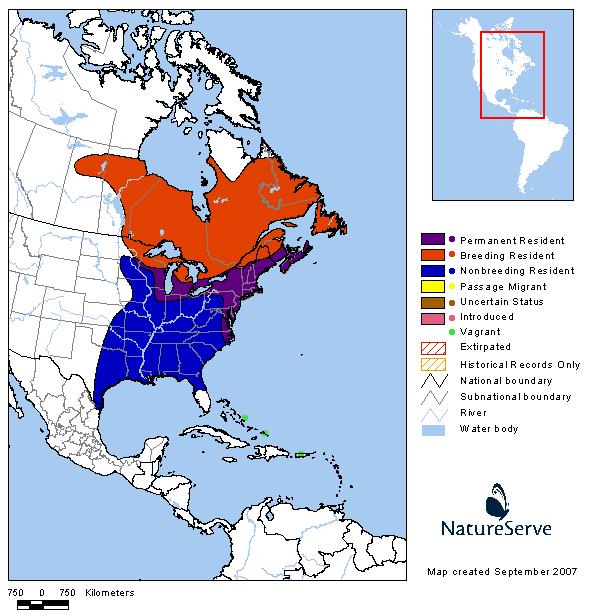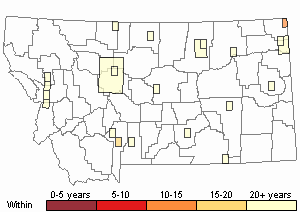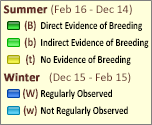View in other NatureServe Network Field Guides
NatureServe
Montana
Utah
Wyoming
Idaho
Wisconsin
British Columbia
South Carolina
Yukon
California
New York
American Black Duck - Anas rubripes
General Description
Males have dark blackish-brownish body feathers with a lighter grayish head, finely streaked neck and olive-colored beak; feet are reddish orange. Female American Black Ducks look similar, but are lighter in color than males. American Black Duck plumage is similar to that of Mallards, however, they lack the bright green head and neck breeding plumage of Mallards (
Anas platyrhychos).
For a comprehensive review of the conservation status, habitat use, and ecology of this and other Montana bird species, please see
Marks et al. 2016, Birds of Montana.Species Range
Accidental
Western Hemisphere Range

Observations in Montana Natural Heritage Program Database
Number of Observations: 52
(Click on the following maps and charts to see full sized version)
Map Help and Descriptions
Relative Density

Recency

SUMMER (Feb 16 - Dec 14)
Direct Evidence of Breeding

Indirect Evidence of Breeding

No Evidence of Breeding

WINTER (Dec 15 - Feb 15)
Regularly Observed

Not Regularly Observed



 (Observations spanning multiple months or years are excluded from time charts)
(Observations spanning multiple months or years are excluded from time charts)
Migration
Pairs form during fall and winter, before spring breeding. Usually arrives on breeding areas already paired; one of first ducks in northern areas before ice thaws (Longcore et al. 2000).
Habitat
During the breeding season, American Black Ducks nest in wooded swamps, shallow lakes, and wooded wetlands, including beaver ponds and altered wetlands. Migrant American Black Ducks use tidal flats, lakes, ponds, and resevoirs as stopover habitat. Individuals winter in flooded timber, emergent wetlands, and saltmarshes.
Food Habits
Diet consists of insects, worms, aquatic vegetation, along with grass, berries and sometimes grain.
Ecology
Genetically, the American Black Duck and the Mallard are nearly identical.
Reproductive Characteristics
Typically single-brooded; clutch consisting of 8 to 10 eggs. Eggs are laid in spring with incubation lasting 26 to 29 days. Nests are found in sheltered wooded areas, including thickets and meadows.
References
- Literature Cited AboveLegend:
 View Online Publication
View Online Publication Longcore, J. R., D. G. McAuley, G. R. Hepp, and J. M. Rhymer. 2000. American Black Duck (Anas rubripes). In The birds of North America, No. 481 (A. Poole and F. Gill, Eds.). Academy of Natural Sciences of Philadelphia and American Ornithologists’ Union.
Longcore, J. R., D. G. McAuley, G. R. Hepp, and J. M. Rhymer. 2000. American Black Duck (Anas rubripes). In The birds of North America, No. 481 (A. Poole and F. Gill, Eds.). Academy of Natural Sciences of Philadelphia and American Ornithologists’ Union. Marks, J.S., P. Hendricks, and D. Casey. 2016. Birds of Montana. Arrington, VA. Buteo Books. 659 pages.
Marks, J.S., P. Hendricks, and D. Casey. 2016. Birds of Montana. Arrington, VA. Buteo Books. 659 pages.
- Additional ReferencesLegend:
 View Online Publication
View Online Publication
Do you know of a citation we're missing? American Ornithologists’ Union [AOU]. 1998. Check-list of North American birds, 7th edition. American Ornithologists’ Union, Washington, D.C. 829 p.
American Ornithologists’ Union [AOU]. 1998. Check-list of North American birds, 7th edition. American Ornithologists’ Union, Washington, D.C. 829 p. Ehrlich, P., D. Dobkin, and D. Wheye. 1988. The birder’s handbook: a field guide to the natural history of North American birds. Simon and Schuster Inc. New York. 785 pp.
Ehrlich, P., D. Dobkin, and D. Wheye. 1988. The birder’s handbook: a field guide to the natural history of North American birds. Simon and Schuster Inc. New York. 785 pp. Hansen, R.M. 1962. Movements and survival of Thomomys talpoides in a mima-mound habitat. Ecology 43(1):151-154.
Hansen, R.M. 1962. Movements and survival of Thomomys talpoides in a mima-mound habitat. Ecology 43(1):151-154. Hays, R., R.L. Eng, and C.V. Davis (preparers). 1984. A list of Montana birds. Helena, MT: MT Dept. of Fish, Wildlife & Parks.
Hays, R., R.L. Eng, and C.V. Davis (preparers). 1984. A list of Montana birds. Helena, MT: MT Dept. of Fish, Wildlife & Parks. Johnsgard, P.A. 1992. Birds of the Rocky Mountains with particular reference to national parks in the northern Rocky Mountain region. Lincoln: University of Nebraska Press. xi + 504 pp.
Johnsgard, P.A. 1992. Birds of the Rocky Mountains with particular reference to national parks in the northern Rocky Mountain region. Lincoln: University of Nebraska Press. xi + 504 pp. Joslin, Gayle, and Heidi B. Youmans. 1999. Effects of recreation on Rocky Mountain wildlife: a review for Montana. [Montana]: Montana Chapter of the Wildlife Society.
Joslin, Gayle, and Heidi B. Youmans. 1999. Effects of recreation on Rocky Mountain wildlife: a review for Montana. [Montana]: Montana Chapter of the Wildlife Society. Korschgen, C.E., and R.B. Dahlgren. 1992. Human disturbances of waterfowl: causes, effects, and management. Ch. 13.2.15 In: Waterfowl Management Handbook. Fish and Wildlife Service Leaflet. 8 p.
Korschgen, C.E., and R.B. Dahlgren. 1992. Human disturbances of waterfowl: causes, effects, and management. Ch. 13.2.15 In: Waterfowl Management Handbook. Fish and Wildlife Service Leaflet. 8 p. Lenard, S., J. Carlson, J. Ellis, C. Jones, and C. Tilly. 2003. P. D. Skaar's Montana bird distribution, 6th edition. Montana Audubon, Helena, MT. 144 pp.
Lenard, S., J. Carlson, J. Ellis, C. Jones, and C. Tilly. 2003. P. D. Skaar's Montana bird distribution, 6th edition. Montana Audubon, Helena, MT. 144 pp. Montana Bird Distribution Committee. 2012. P.D. Skaar's Montana bird distribution. 7th Edition. Montana Audubon, Helena, Montana. 208 pp. + foldout map.
Montana Bird Distribution Committee. 2012. P.D. Skaar's Montana bird distribution. 7th Edition. Montana Audubon, Helena, Montana. 208 pp. + foldout map. National Geographic Society. 1983. Field guide to the birds of North America. Second Edition. National Geographic Society, Washington, DC.
National Geographic Society. 1983. Field guide to the birds of North America. Second Edition. National Geographic Society, Washington, DC. Palmer, R.S. 1962. Handbook of North American birds. Volume 1. Loons through flamingos. Yale University Press, New Haven. 567 pp.
Palmer, R.S. 1962. Handbook of North American birds. Volume 1. Loons through flamingos. Yale University Press, New Haven. 567 pp. Ragnal, Wendy, and Troy Brandt, Wetland Services, Helena, MT., 1998, Tucker Crossing Ranch Wetland Mitigation Project for Montana Dept. of Transportation: Highway 93 - Hamilton to Lolo: 1998 - Year Two Monitoring Report - Addendum. In Tucker Crossing Site WS# Lower Clark Fork, Ravalli County. Fin.Dist.1 Admin. Dist.1
Ragnal, Wendy, and Troy Brandt, Wetland Services, Helena, MT., 1998, Tucker Crossing Ranch Wetland Mitigation Project for Montana Dept. of Transportation: Highway 93 - Hamilton to Lolo: 1998 - Year Two Monitoring Report - Addendum. In Tucker Crossing Site WS# Lower Clark Fork, Ravalli County. Fin.Dist.1 Admin. Dist.1 Rhodes, O.E., Jr., L.M. Smith and M.H. Smith. 1991. Conservation and genetic resources in waterfowl. Trans. N. Amer. Wildl. & Nat. Res. Conf. 56:462-472.
Rhodes, O.E., Jr., L.M. Smith and M.H. Smith. 1991. Conservation and genetic resources in waterfowl. Trans. N. Amer. Wildl. & Nat. Res. Conf. 56:462-472. Sibley, D. 2014. The Sibley guide to birds. Alfred A. Knopf, New York, NY. 598 pp.
Sibley, D. 2014. The Sibley guide to birds. Alfred A. Knopf, New York, NY. 598 pp. Skaar, P. D., D. L. Flath, and L. S. Thompson. 1985. Montana bird distribution. Montana Academy of Sciences Monograph 3(44): ii-69.
Skaar, P. D., D. L. Flath, and L. S. Thompson. 1985. Montana bird distribution. Montana Academy of Sciences Monograph 3(44): ii-69. Skaar, P.D. 1969. Birds of the Bozeman latilong: a compilation of data concerning the birds which occur between 45 and 46 N. latitude and 111 and 112 W. longitude, with current lists for Idaho, Montana, Wyoming, impinging Montana counties and Yellowstone National Park. Bozeman, MT. 132 p.
Skaar, P.D. 1969. Birds of the Bozeman latilong: a compilation of data concerning the birds which occur between 45 and 46 N. latitude and 111 and 112 W. longitude, with current lists for Idaho, Montana, Wyoming, impinging Montana counties and Yellowstone National Park. Bozeman, MT. 132 p. Taylor, D.M. and C.H. Trost. 1987. The status of historically rare of unrecorded birds in Idaho. Unpublished manuscript. 68 p.
Taylor, D.M. and C.H. Trost. 1987. The status of historically rare of unrecorded birds in Idaho. Unpublished manuscript. 68 p. U.S. Forest Service. 1991. Forest and rangeland birds of the United States: Natural history and habitat use. U.S. Department of Agriculture, Forest Service Agricultural Handbook 688. 625 pages.
U.S. Forest Service. 1991. Forest and rangeland birds of the United States: Natural history and habitat use. U.S. Department of Agriculture, Forest Service Agricultural Handbook 688. 625 pages.
- Web Search Engines for Articles on "American Black Duck"
- Additional Sources of Information Related to "Birds"





